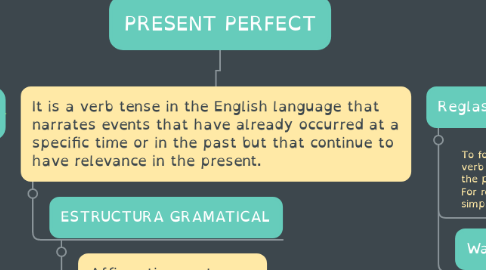
1. It is a verb tense in the English language that narrates events that have already occurred at a specific time or in the past but that continue to have relevance in the present.
1.1. ESTRUCTURA GRAMATICAL
1.1.1. Affirmative sentences
1.1.1.1. Subject + auxiliary verb (to have) + past participle
1.1.1.1.1. Example: I have seen a good movie this week.
1.1.2. Negative sentences
1.1.2.1. Subject + auxiliary verb (to have) "not" + past participle
1.1.2.1.1. Example: He hasn’t played.
1.1.3. Interrogative sentences
1.1.3.1. Auxiliary verb (to have) + subject + past participle ...?
1.1.3.1.1. Example: Have you worked for your uncle?
2. What is it?
3. Reglas gramaticales
3.1. To form the present perfect, the auxiliary verb "to have" is used in the present and the past participle of the verb. For regular verbs, the past participle is the simple form of the past.
3.2. Ways of use
3.2.1. The present perfect is used for actions that occurred at a non-specific time before now. The specific time is not important. Therefore, we do not usually use specific time expressions ("this moming", "yesterday", "last year" ...) with the present perfect. You can use the present perfect with non-specific time expressions "refrigerator", "Ever", "many times", "for", "since", "already", "yet" ...).
